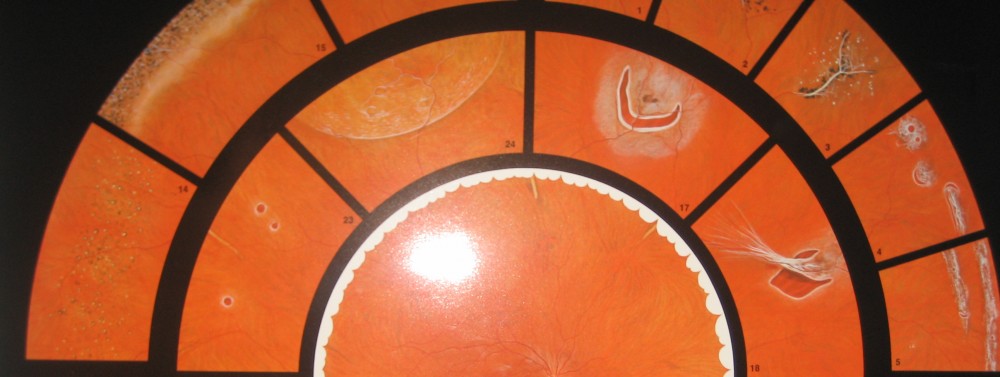A recent analysis of DNA in the AREDS study showed that AMD genes influenced the success or failure of zinc in the vitamin formula. Commonly consumed zinc supplements may even be harmful. Now doctors can detect these genes and tailor the amount of zinc in the vitamin formula to optimize the chances that it will help prevent advanced AMD with vision loss.
Author Archives: sepizia
Do You Have a Family History of Age-Related Macular Degeneration?
Eye freckles?
Eye freckles? Dark spots on iris may be caused by sun exposure
Date:
July 19, 2017
Source:
Association for Research in Vision and Ophthalmology (ARVO)
Summary:
In a study well-timed for summer, vision scientists have found that eye freckles, dark spots on the colored part of the eye (iris), are more frequently found in people with higher lifetime exposure to sunlight. While not malignant, eye freckles could indicate the presence or risk of sunlight-triggered eye diseases like cataract or macular degeneration.
Lutein
Lutein, found in leafy greens, may counter cognitive aging
Date:
July 25, 2017
Source:
University of Illinois at Urbana-Champaign
Summary:
Spinach and kale are favorites of those looking to stay physically fit, but they also could keep consumers cognitively fit, according to a new study. The study, which included 60 adults aged 25 to 45, found that middle-aged participants with higher levels of lutein — a nutrient found in green leafy vegetables such as spinach and kale, as well as avocados and eggs — had neural responses that were more on par with younger individuals than with their peers.
Dietary and Lifestyle recommendations for Macular degeneration patients
Dietary and lifestyle recommendations for patients at risk of macular degeneration
Date:
June 23, 2017
Source:
Dove Medical Press
Summary:
Age-related macular degeneration (AMD) is a major cause of severe visual impairment in older populations and is characterized by progressive destruction of the retinal pigment epithelial cells and photoreceptors due to low-grade inflammation, ischemia and oxidative stress. Studies show evidence that carotenoids and antioxidants derived either from the diet or from supplements may significantly reduce the risk of visual loss in these patients.
BLue Light
The specific band of blue light most harmful to the retina and to the RPE cells was identified to be at 415 nm to 455 nm.
The blue-violet light that was discovered as part of this study is a 40 nm band of visible light that causes the maximum retinal cell death. Over time, our eyes are exposed to various sources that emit this blue-violet light (e.g., the sun, LED lighting, CFLs). Combine that with the use of tablets, TVs, computer screens and smart phones, and there’s no doubt our exposure to blue-violet light is on the increase. This cumulative and constant exposure to the blue-violet light is going to accumulate over time and has the potential to cause damage to the retinal cells, which is going to slowly lead to retinal cell death and can in turn lead to AMD.
The level of light emitted by newer energy-saving lighting techniques (e.g., LED, CFLs) is very high. For example, CFLs, white LED light and even sunlight emit high levels of blue-violet light compared to the rest of the blue light spectrum. This underscores the need for us to protect our eyes from the harmful bands of blue-violet light.
What is the blue light from our screens really doing to our eyes?
BLue Light Hazards
University of Utah Health Sciences
Summary:
Brain scans from nearly 200 adolescent boys provide evidence that the brains of compulsive video game players are wired differently. Chronic video game play is associated with hyperconnectivity between several pairs of brain networks. Some changes are predicted to help game players respond to new information. Others are associated with distractibility and poor impulse control.
Allergy
Tips on how to reduce your allergy symptoms this allergy season:
· Wash your hair before sleep to remove trapped pollens.
· Rinse your nostrils lightly with saline solution daily to remove irritants.
· Keep windows closed to protect inside air from contaminants.
· Run the air conditioner and air purifier to remove pollutants.
· Leave outdoor-exposed gear such as shoes and backpacks on the porch steps to preserve interior air.
· Cover mouth with a handkerchief or mask when doing spring yard cleanups including raking, edging and mowing.
High Rate Of Vision Problems After Traumatic Brain Injury Found In In Combat Vets And Others
Visual symptoms and abnormalities occur at high rates in people with traumatic brain injury (TBI).
Vision-related symptoms, including difficulty reading, light sensitivity, more likely to have problems related to eye movement (saccadic dysfunction), blurred vision caused by focusing problems (accommodative dysfunction) and problems moving the eyes together to focus on near objects (convergence insufficiency).The high rate of visual problems occurred even though most patients had normal visual acuity.
What Is Glaucoma? What Causes Glaucoma?
Glaucoma is a disease of the eye in which fluid pressure within the eye rises – if left untreated the patient may lose vision, and even become blind. The disease generally affects both eyes, although one may have more severe signs and symptoms than the other.
There is a small space in the front of the eye called the “anterior chamber”. Clear liquid flows in-and-out of the anterior chamber, this fluid nourishes and bathes nearby tissues. If a patient has glaucoma, the fluid does not drain properly – it drains too slowly – out of the eye. This leads to fluid build-up, and pressure inside the eye rises. Unless this pressure is brought down and controlled, the optic nerve and other parts of the eye may become damaged, leading to loss of vision.
Vision Problems In Children Born Preterm – What Are The Risk Factors?
Visual impairment in extremely preterm children is mainly due to Retinopathy Of Prematurity (ROP), although cerebral damage, often referred to as cerebral visual impairment, can also be a cause amongst those born extremely premature.
